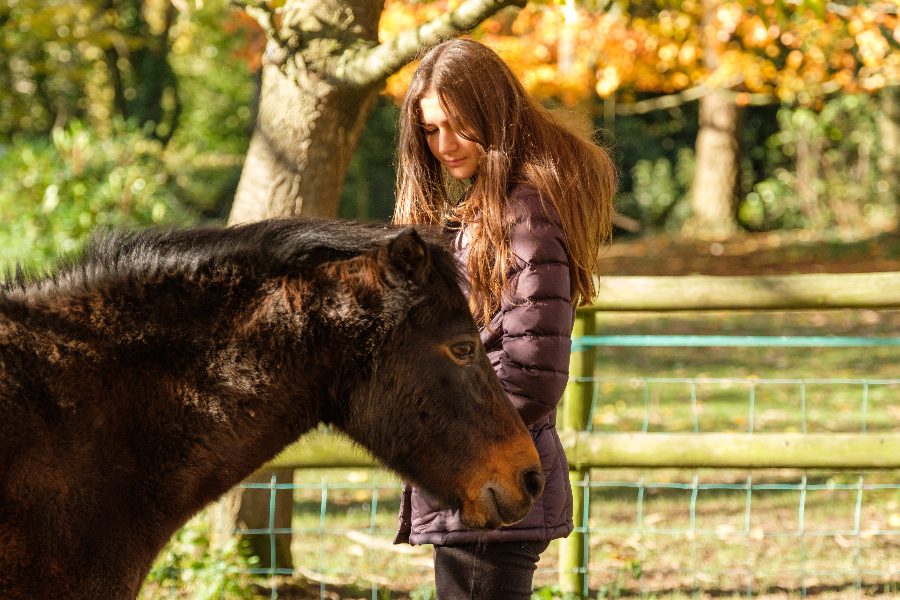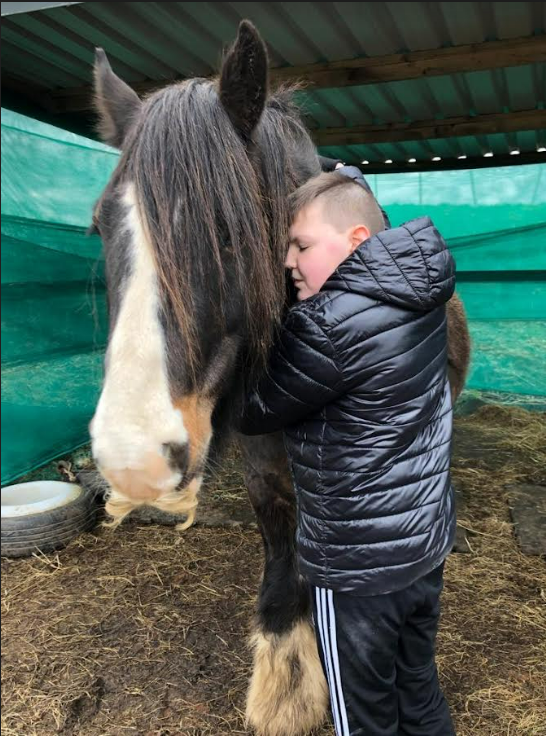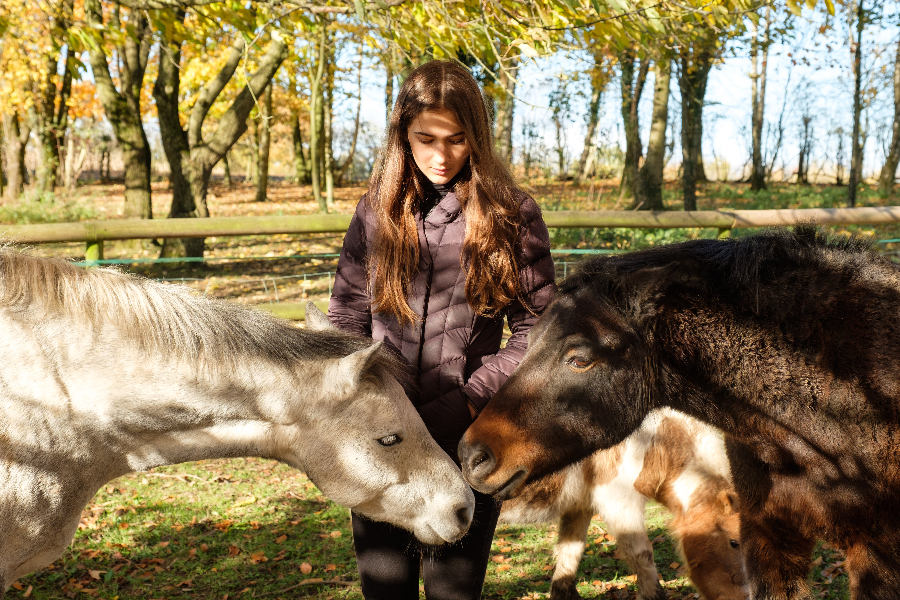Equine-assisted services: A valuable but misunderstood resource for child and adolescent mental health
Media
Image

Media description
Photo credit: Equine Assisted Psychotherapy Sessions at Track Clinic, Frome, Somerset. 2018Courtesy of Nina Leijerstam, Founder of Track Clinic. Photograph by Joss Barratt. For more information: www.trackclinic.co.uk
Blog content
As the world faces a global mental health (GMH) crisis among children and adolescents alongside a shortage of specialist care, it has become increasingly clear that the alarm bells being sounded by GMH advocates are anything but alarmist. The statistics are harrowing, with the WHO reporting that depression is one of the foremost causes of illness and disability among adolescents; suicide is the third leading cause of death in young people between the ages of 15 and 19; and mental health conditions account for 16% of the global burden of disease and injury in those aged 10-19 years.
The reality of the situation is that there are millions of young people who need care worldwide, not enough specialists to provide that care, and valid concern that standard treatment practices are not effective enough. Within the global mental health sphere, there are two avenues practitioners often advocate for: one is scaling-up available evidence-based treatments via task-shifting, while the other is investing in innovative, community-based methods of care.
Interestingly, in the search for innovative interventions that are efficacious for diverse groups, which can be scaled-up worldwide and can employ a model of task-shifting to compensate for resource scarcity, an existing resource that is a potentially valuable asset to GMH but has been overlooked in this context is that of equine-assisted services.

Equine-assisted services (EAS), a unifying term delineated by Wood et al. (2021), refers to multiple services in which horses and other equines are utilized to benefit people. These services fall under three main categories: therapy, learning, and horsemanship. Each service has different goals and necessitates particular levels of training for the individual delivering them. In this way these services are rather unique as they already have a hierarchy of task-shifting within them: some EAS must be delivered by a licensed psychologist (i.e., equine-assisted psychotherapy) while others can be administered by professionals of non-mental health backgrounds or layworkers (i.e., equine-assisted learning; horsemanship). This presents a unique opportunity to expand mental health care capacity for children and adolescents worldwide, as EAS can be delivered by specialists, nonspecialists, and layworkers to treat significant mental health issues, provide less clinically severe or at-risk populations with support and/or preventative care, and to promote well-being and resilience. In theory, service-users could be matched appropriately within the hierarchy of established EAS based on treatment goals and the level of support required.
While EAS are currently delivered worldwide, from South Korea to Afghanistan to Guatemala, and are purported to be effective across a range of psychosocial issues, the literature is lacking, and there is little formal support from organizations like the NHS.
My main two Research Questions for my MSc dissertation on EAS are:
1) What is preventing EAS from becoming established as an effective mental health resource for children and adolescents?
2) What measures need to be taken in order to improve the trajectory of EAS?

Due to the variability of the work, I decided the best approach would be an exploratory qualitative analysis of interviews conducted with EAS practitioners of varying backgrounds in the UK. After conducting semi-structured interviews with 12 practitioners using 16 open-ended questions, covering topics ranging from their professional background and training to how they conduct a session, three major themes emerged: eclecticism, unique benefits of the horse, and organizational issues.
Eclecticism refers to an established concept in psychology also known as ‘prescriptive eclecticism’ which is a form of integrative psychotherapy that attempts to customize psychological methods and therapeutic relationships to the individual client. In terms of EAS delivery, all the practitioners interviewed stated that they do not rigidly adhere to one method, with everything from CBT to EMDR and somatic experiencing being cited as examples of what could be incorporated into an EAS session if it best suits the client.
Another theme was unique benefits of the horse, which was a crucial finding because it highlights that the horse is the main resource that prompts client growth. Practitioners universally highlighted that horses act as co-therapists by providing a nonjudgmental space for clients to just be, providing excellent biofeedback because of their nature as prey animals, and serving as a bridge between worlds. Essentially, clients can experientially work through their problems with practitioner support in a controlled setting that is lower stakes than being out in the real world on their own, with an animal whose feedback is perceived to be nonjudgmental and less threatening than human feedback.
Lastly, we have organizational issues, which was an important finding as this answers the main question of what is impeding EAS from becoming a reputable mental health resource. All practitioners felt like EAS do not have enough strategic backing or regulation behind them, which makes it difficult for them to collaborate with sectors like the NHS, which in turn makes it difficult to develop their programs and provide evidence for their efficacy. Furthermore, several practitioners noted they did not feel typical research methods appropriately capture this type of work. This observation is in line with findings from the literature, as several mixed method studies provided strong qualitative evidence for the efficacy of EAS, while the quantitative data in the same studies yielded lackluster results.

There were several important takeaways that came from this work, a few of which I only recently discovered thanks to having the opportunity to present my research at the University of Edinburgh’s Pluralizing Mental Health Conference. Thinking about my dissertation in relation to the themes of the EdCMA led me to think more deeply about whether these findings have greater applicability to GMH than I initially explored, and I wound up discovering several new connections. There are two in particular I would like to highlight here, as I feel they are especially relevant to GMH as community-based mental health initiatives expand.
The first is the question of regulation and quality control. A major concern that came out of this work is how to ensure that service-users are protected when they utilize innovative community-based approaches. While EAS do have trainings and licensures available in order to deliver the work, it is not a requirement and the quality of such trainings is variable. When the work is done properly it is reported to be effective but with such little oversight, it would be easy for service-users to wind up utilizing services of poor quality, and for those services to be included in research studies.
The second is the question of what counts as evidence. How do we ensure that our research methods are rigorous but flexible enough to capture the complexities of innovative psychological interventions?
These two questions will become particularly important as community-based initiatives expand and necessitate real solutions that ultimately require cooperation from and collaboration with the larger scientific community and formal healthcare sectors if they are to be accepted. In terms of this work, I hope to publish my dissertation by the end of the year and use it as a foundation to conduct more targeted research within the field of EAS, as well as explore more suitable research methods for evaluating complex community-based interventions.
Madison Charlton received her B.A. in Psychology from New York University and recently completed her MSc in Global Mental Health at the University of Edinburgh. She currently works for a youth charity in London that facilitates early intervention and leadership programmes for at-risk teenagers.
